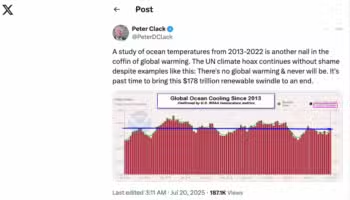- Geology
NASA’s ocean exploration and research is ongoing; no mysterious discovery stopped their efforts, contrary to social media claims
Key takeaway
Some of NASA’s earliest research of Earth’s oceans started in 1978, with the launch of their first oceanographic satellite. There is no evidence that their ocean exploration and research efforts have stopped. In fact, in 2017 NASA joined the 3-year SUBSEA research program to study underwater volcanoes in the ocean at depths of up to 4000 meters (13,123 feet). In February 2024, NASA launched the Plankton, Aerosol, Cloud, ocean Ecosystem (PACE) satellite, which will be used to study microscopic life in Earth’s oceans.
Reviewed content
Verdict detail
Factually inaccurate: NASA’s ocean exploration did not stop in 1978. In fact, that is the year that their first oceanographic satellite was launched. Since that time, NASA has continued to explore and research Earth’s oceans, as evidenced by the 2017 SUBSEA research program and 2024 launch of the PACE satellite.
Full Claim
The National Aeronautics and Space Administration (NASA) began exploring the deep sea in 1958, but stopped exploring oceans in 1978 or 2014 because of an undisclosed, mysterious discovery.
Since 2022, videos have circulated on TikTok and Facebook claiming that ‘NASA has stopped exploring the oceans because of some undisclosed discovery’. These videos have collectively gathered tens of million views. However, the details shared are inconsistent; the videos claim that exploration started in 1958, but stopped in either 1978 or 2014 due to a range of alleged ‘mysterious discoveries’. Below we will investigate this claim using available evidence.
NASA has explored and researched Earth’s oceans for decades; these efforts have not stopped
The National Aeronautics and Space Administration (NASA) is an independent agency of the United States government which “studies Earth, including its climate, our Sun, and our solar system and beyond”, according to their official website. Although their areas of research are quite extensive – e.g., their Earth and climate research linked here – this has not always been the case. Contrary to what is claimed in social media videos, NASA’s ocean exploration efforts did not begin in 1958. Although NASA was established in 1958 after the National Aeronautics And Space Act was passed, their first efforts were directed toward space exploration. Specifically, they were focused on sending spacecraft and astronauts to the Moon, as detailed in the timeline linked here. However, they later expanded their research endeavors. According to their oceanography page, “NASA has been observing the oceans from space for more than 20 years. NASA launched Seasat, the first civilian oceanographic satellite, on June 28, 1978”. Thus, contrary to what videos on social media claim, NASA’s ocean observations began in 1978 – they did not end that year. In fact, their ocean exploration and research did not end at all, as evidenced by their ongoing research efforts. In 2017, NASA joined the 3-year SUBSEA research program to study underwater volcanoes in the ocean at depths of up to 4000 meters (13,123 feet). This research was completed in partnership with NOAA and the Ocean Exploration Trust; the former has provided a helpful overview of the research on their website linked here. An example of the underwater craft used is shown below in Figure 1, and some of the shore-based NASA team monitoring the expedition[1] in Figure 2.
Figure 1 – Exploration Vessel Nautilus (E/V Nautilus) in 2018 at Kamaʻehuakanaloa (formerly Lō`ihi Seamount) as part of the SUBSEA research program. Source: Ocean Exploration Trust
Figure 2 – A shore-based NASA SUBSEA team stationed at the ISC Mission Control for the 2019 E/V Nautilus expedition. Source: Ocean Exploration Trust and Raineault et al. (2019)[1]
Another recent example of their ocean research efforts is the February 2024 launch of their Plankton, Aerosol, Cloud, ocean Ecosystem (PACE) satellite. A NASA news release explains that “PACE will study microscopic life in the oceans and microscopic particles in the atmosphere”. The most recent PACE Technical Report from March 2024 can be viewed in this link[1].These research efforts are integral to NASA’s mission, as they explain: “part of NASA’s mission is to develop an understanding of the total Earth system and the effects of natural and human-induced changes on the global environment. Our oceans play a major role in influencing changes in the world’s climate and weather.”
Conclusion
Some of NASA’s earliest research of Earth’s oceans started in 1978. Contrary to viral social media videos, these efforts have continued. Evidence of NASA’s continued ocean exploration and research include their partnership in the 3-year SUBSEA research program studying the deep oceans, and data collection from their PACE satellite launched in February 2024, which will be used to study microscopic life in Earth’s oceans. The claims made in viral social media videos about NASA stopping ocean exploration in 1978 or 2014 are inaccurate, based on clear evidence of their ongoing research efforts.
REFERENCES
- 1- Raineault et al. (2019). New frontiers in ocean exploration: The E/V Nautilus, NOAA Ship Okeanos Explorer, and R/V Falkor 2018 field season. Oceanography.






